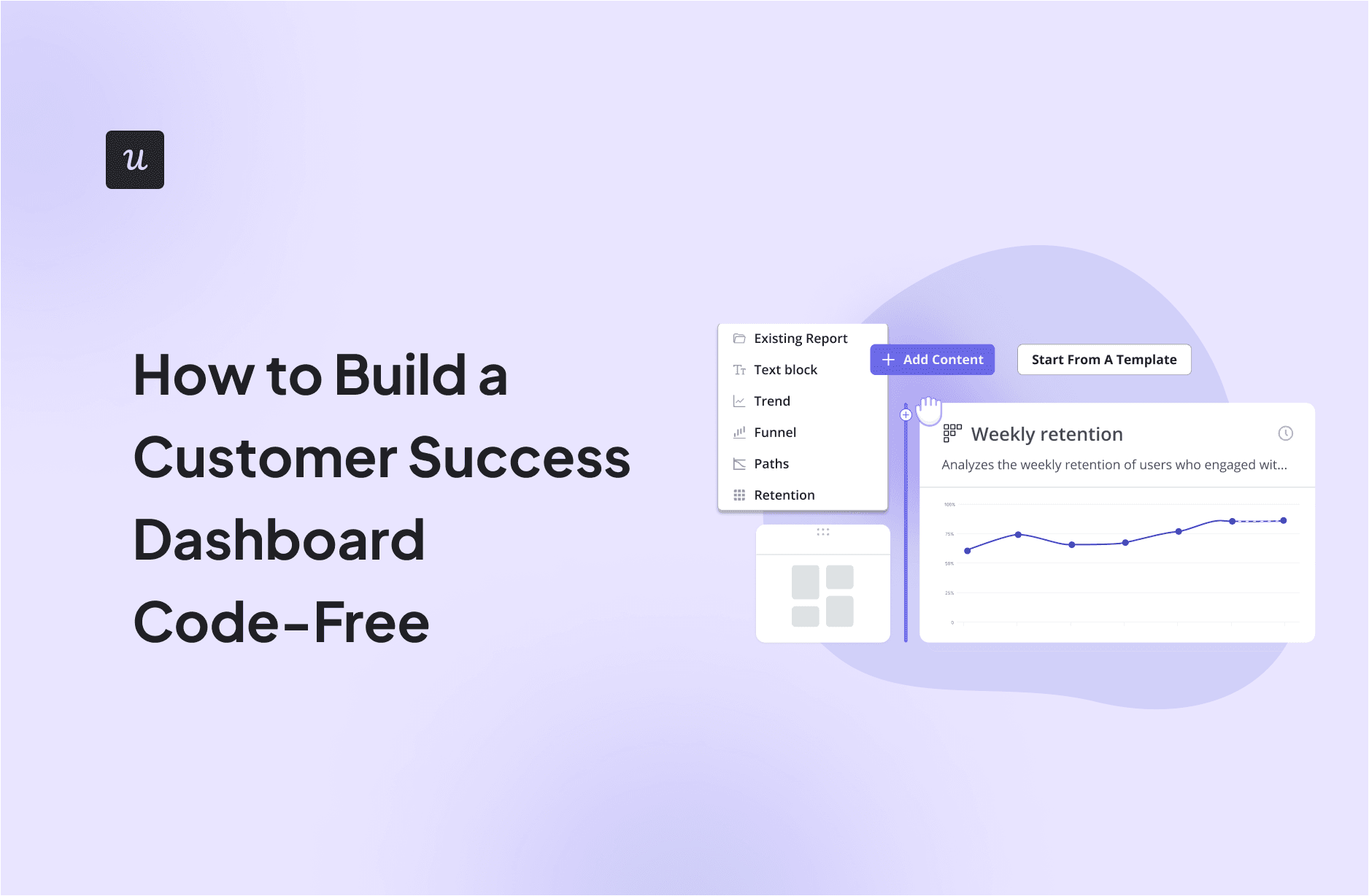
Wondering how to build a customer success dashboard for your team?
If so, we’ve got you covered!
From the article, you will learn what a customer success dashboard is, why you need it, and what metrics it should include. And how to build a dashboard for your customer success team using Userpilot analytics!
Let’s dive right in!
Get The Insights!
The fastest way to learn about Product Growth, Management & Trends.
Overview customer success dashboard
- A customer success dashboard is a kind of report where you can access and visualize all relevant customer success data.
- The dashboard improves the productivity of the customer success teams, allows them to identify issues in real-time, and helps them make better-informed decisions.
- Important customer success metrics include CSAT, NPS, Customer retention rate, Onboarding completion rate, and Customer Health Score.
- Userpilot is a product adoption and customer success solution that allows you to create custom dashboards. Here’s the process:
- Choose the metrics to track and decide how to collect the data.
- Navigate to Dashboards in the menu and choose Create New.
- Choose one of the 3 templates or click Add content to start from scratch.
- Populate your dashboard with up to 30 reports. You can choose an existing report, a text block, or create one of the 4 main analytics reports (Trends, Funnels, Paths, Retention).
- Customize the dashboard by dragging and dropping the widgets, changing their size, filtering the data, and setting custom timeframes.
- Share the dashboard with relevant stakeholders.
- To find out more about Userpilot dashboards, book the demo!
What is a customer success dashboard?
A customer success dashboard is a visualization tool that helps customer success teams monitor KPIs related to customer engagement, satisfaction, and retention.
Why does your team need a CS dashboard?
- A customer success dashboard enables teams to access all the data they need in one place, without switching between tools or reports.
- Visual representations of customer data help CS teams identify patterns, track trends, and spot correlations between data sets. To inform your customer success strategy.
- It allows you to monitor the key metrics in real time so that you can promptly identify and address issues your customers experience. To improve their satisfaction and prevent churn.
- By automating the tracking and reporting processes, dashboards save time and reduce errors. For higher team productivity and efficiency.
Customer success metrics to include in your dashboard
What metrics should you track in your customer success dashboard? It depends on your organization, product, and objectives.
However, there are a few that most teams will find useful.
- <Customer Satisfaction Score (CSAT) is a measure of how satisfied customers are with your product. It allows companies to quickly identify customer experience issues.
- Customer Effort Score (CES) assesses the ease of interaction with the product. A low effort score indicates the product is easy to use, doesn’t cause unnecessary frustration, and is often correlated with customer retention.
- Net Promoter Score (NPS) measures customer loyalty, which is essential for customer retention and long-term product success. Loyal customers are also more likely to participate in referral programs and spread good word of mouth.
- Customer churn rate is the percentage of customers who cancel or don’t renew their subscriptions. High churn can significantly erode the customer base and revenue.
- Customer Lifetime Value (CLV) is the total revenue a business can expect from a single customer account throughout their relationship. Understanding CLV helps optimize marketing spend and identify the most valuable customers.
- Product usage rate measures how frequently customers use the product or its features. Usage rates indicate customer engagement levels, help identify potential upsell opportunities, and assess product value perception.
- The onboarding completion rate tracks the percentage of new customers who complete the onboarding process. Effective onboarding sets the stage for how well customers understand and use the product.
- Free-to-paid conversion rate measures the percentage of users who convert from a free trial or freemium to a paid subscription. It’s an indicator of the initial value users perceive in your product and the effectiveness of your onboarding process.
- Customer Health Score is a metric combining various indicators of customer health, like product usage, customer engagement, support ticket activity, and satisfaction scores. It helps predict customer retention and identify customers who might need extra support.
- Monthly Recurring Revenue (MRR) tracks the total monthly revenue generated from all active subscriptions. MRR is vital for understanding the financial health of your SaaS business and forecasting future revenue.
How to create a customer success KPI dashboard in Userpilot
Userpilot is a product growth and customer success platform. It enables teams to collect customer feedback, analyze user in-app behavior, and use the insights to create interactive in-app experiences. To drive product adoption, retention, and account expansion.
Earlier this year, Userpilot launched 4 pre-built analytics dashboards (Product Usage, New User Activation, Core Feature Engagement, and User Retention) and now you can create custom dashboards.
Here’s how to build a customer success dashboard.
Step 1: Decide how you want to track customer success
Before you create your dashboard, define what customer success means for your product.
In other words, choose the metrics you want to track to measure it.
The choice of metrics determines how you collect the data.
Apart from Userpilot analytics and feedback features, you can also use data from 3rd party apps. Userpilot supports integrations with analytics tools (Amplitude, Heap, Mixpanel, Google Analytics) and CRM platforms (Hubspot, Salesforce).
Step 2: Navigate to analytics dashboards to create a new dashboard
Log into Userpilot.
From the sidebar menu, click on Dashboards, and click on the Create New button at the bottom.

Step 3: Choose a template or create from scratch
Userpilot allows you to build a dashboard from one of the 3 templates: Free Trial to Paid Conversion, Feature Engagement, or Expansion Revenue & Upgrades.
As you’re building a customer success dashboard, click Add Content to create your dashboard from scratch.

Step 4: Add content to your dashboard
You can add up to 30 metrics and analytics reports to your dashboard.
6 different content types include:
- Existing report: one of the Analytics reports you’ve previously created and saved (Trends, Funnels, Paths, Retention).
- Text block: text fields, for example, to explain the context of the data or the purpose of the dashboard.
- Trends: Userpilot allows you to visualize key customer success metrics in graphs. Thanks to this, you can monitor changes over time, spot seasonal trends and identify correlations between data sets.
- Funnel: With Funnel analysis, you can analyze conversion or drop-off rates at key stages in a process. For example, you can use it to identify friction or drop-off points in the onboarding process or user journey.
- Paths: Path analysis enables you to visualize user actions inside the product. You can use it to analyze actions leading to a conversion or drop-off. Insights from path analysis can help you find the most optimal routes to conversion or diagnose the reasons why users fail to convert.
- Retention: visualization of how many users from various cohorts continue using the product over time. Understanding how long users stay active and when their interest starts to wane allows you to engage them with in-app experiences to increase their retention. It also helps you measure the impact of product updates and new features on key metrics.

Step 5: Customize the view of your customer success dashboards
Once you add the reports to the dashboard, tailor it to the needs of your customer support team.
Userpilot allows you to rearrange the reports by dragging and dropping the blocks. You can have up to 4 in the same row so you can group related metrics or reports together.
It doesn’t stop there.
You can also control the width and height of each block. In this way, you can view the most important data in more detail.
You can choose what data to include in the dashboard. You do it by selecting the timeframe and setting filters.
For example, you may want to visualize the data for one user segment only for more granular analysis.
And one last thing: you can mark up to 5 reports as Favorites. These appear in the menu, for easier access.

Step 6: Share your dashboard with customer success managers
Userpilot enables you to share your dashboards with relevant stakeholders.
Thanks to that, you can easily communicate key insights with your customer success manager, for example, to support your proposals or decisions. Or with other teams across the organization to prevent data silos and improve cross-functional alignment.
To do so, click the button with three dots in the top right corner, and choose Share. Add the email address of the recipient and a message. Click Send Invite.

Conclusion
Customer success dashboards enable your teams to track customer success KPIs from one place. This increases their efficiency and enables them to monitor customer success data in real time, make data-driven decisions, and share information with colleagues.
If you’d like to learn more about creating custom dashboards in Userpilot, book the demo!






